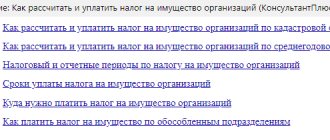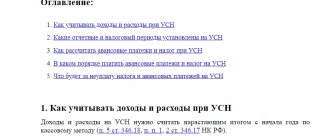Taxation of movable property: history of the issue
From January 1, 2015, fixed assets included in depreciation groups 1 and 2 of the Classification of fixed assets approved by the Government of the Russian Federation ceased to be recognized as objects of taxation (subclause 8, clause 4, article 374 of the Tax Code of the Russian Federation).
At the same time, other objects of movable property are subject to taxation. Moreover, since 2015, such an object has also included property acquired after 01/01/2013, which was not subject to taxation until 2015. However, simultaneously with the exclusion from non-taxable property, it was included in the preferential property.
Thus, all movable property, except for objects of depreciation groups 1 and 2, from 2015, regardless of the date of registration as fixed assets, began to be regarded as subject to taxation. At the same time, property acquired after 01/01/2013 fell under the exemption.
How to calculate property tax for organizations
To produce something interesting to customers, you need to have something. At a minimum, business acumen and entrepreneurial savvy, or even better - useful connections. But in most cases it is impossible to do without a material base. For a manufacturing enterprise, you will need equipment for manufacturing products, for a trading company - warehouse space, for an office - at least computer equipment and furniture.
And for pleasure, including owning something, you have to pay. In this case, property tax. How to calculate property tax for organizations, take into account regional characteristics, and take advantage of benefits? This exciting question is the topic of today's article.
The content of the article:
1. Taxpayers of corporate property tax
2. What is subject to corporate property tax
3. Exemption from corporate property tax
4. Features of paying corporate property tax
5. How to calculate property tax for organizations
6. Amount of corporate property tax
7. Examples of calculating corporate property tax
8. Property tax account in accounting
9. Reporting on corporate property tax
10. Payment of corporate property tax
So, let's go in order.
Taxpayers of corporate property tax
The property tax of organizations is established by Chapter 30 of the Tax Code of the Russian Federation (TC RF) and regional legislation.
Taxpayers of corporate property tax are Russian and foreign organizations, including those not operating in Russia through permanent representative offices.
Tax is paid by those companies that have an object of taxation (Article 373 of the Tax Code). Companies on the general taxation system (OSNO) pay tax on any property on the organization’s balance sheet.
Companies that apply special taxation regimes (USN, EVND, Unified Agricultural Tax) only for certain types of property, more on this later.
What is subject to corporate property tax?
To calculate property tax for organizations, you need to know the object of taxation. The tax is imposed on movable and immovable property of organizations, accounted for as fixed assets (FPE) on account 01 and profitable investments in material assets, accounted for on account 03.
Such property can not only be used by the organization itself, but also be transferred to it to other persons (legal and individual) for temporary possession, disposal, trust management, contributed to joint activities, or can be received under a concession agreement (Article 374).
Real estate is any real estate, except land and natural resources. This is property that cannot be moved without causing damage to the property.
Other, more “exotic” types of property also include real estate:
- airplanes and other aircraft subject to state registration,
- river and sea vessels subject to state registration,
- parking spaces that are parts of buildings if their boundaries are fixed according to cadastral registration rules.
Movable property is other property not classified as real estate. These could be machines, cars, computer equipment.
Organizations that work for OSNO pay tax on both movable and immovable property. As for special regime officers, the rules for them are as follows:
- Organizations on the simplified tax system and UTII pay tax on the following real estate: administrative and business centers, shopping centers, non-residential premises for offices, retail facilities, public catering and consumer services, according to which the cadastral value is determined (clause 2 of article 346.11, art. 378.2)
- Organizations on the Unified Agricultural Tax on real estate used in their main activities do not pay property tax. The remaining property of agricultural producers is subject to taxation.
Exemption from corporate property tax
Article 374 lists property that is not subject to taxation . For example, movable property belonging to depreciation groups 1 and 2 according to the OS Classifier (it does not matter what useful life is established for property of groups 1 and 2 in accounting), objects of cultural heritage, ships registered in the Russian International Register of Ships, etc. .
Example 1
The property belongs to group 2. According to the manufacturer's information, the useful life is 7 years. Is it possible in this case to be exempt from corporate property tax? Such property is not subject to corporate property tax. If the company has no other property, a property tax declaration and calculation are not required.
Also exempt from property tax :
- Organizations on the simplified tax system and UTII for movable property,
- Organizations on the Unified Agricultural Tax for property not used in their main activities.
The list of organizations and property for which tax exemption applies is given in Article 381 of the Tax Code of the Russian Federation “Tax benefits”. For example, religious organizations and organizations and institutions of the penal system are completely exempt from tax. Organizations of people with disabilities are exempt from property taxes if certain conditions are met.
From 2021, tax benefits on movable property acquired after 2013 are valid if such benefits are established by regional legislation.
From 2021, regional authorities can establish an additional benefit for property no older than 3 years.
Features of paying corporate property tax
Features of the property tax of organizations are determined by the type of property:
- The basis for calculating the tax for movable property and property for which there is no rule to determine its value as the cadastral value of the object is determined as the average annual residual value of the objects in accounting. This value will be directly affected by your accounting policy; read about it here.
- The basis for calculating property tax, by which the cadastral value is determined, is calculated from its cadastral value . Such property includes business centers and shopping malls, other real estate intended for offices and retail space, and real estate owned by foreign owners.
Let us consider the features of the corporate property tax for the first case.
For the property specified in paragraph 25 of Article 381 of the Tax Code of the Russian Federation, depending on whether regional benefits are established or not, and if established, then in what amount, 4 main cases can be distinguished:
- The regional authorities have not established any benefits . In this case, movable property is subject to property tax at a rate of 1.1%.
- The benefit is established for movable property without indicating the length of time the property is on the organization’s balance sheet or any other restrictions (tax rate 0%). The tax on such property is zero.
- Property may be partially exempt . For example, in the Jewish Autonomous Region, in relation to the movable property of organizations specified in paragraph 25 of Art. 381 of the Tax Code of the Russian Federation, the tax rate is set for 2021 at 0.5%.
- Some regions, for example St. Petersburg, have introduced a benefit for movable property no older than 3 years .
How to calculate property tax for organizations
Above, we determined when the property tax of organizations can be calculated based on the average annual (residual value) of property . In this case, the tax for the year is calculated as follows:
- the residual value of the property is summed up on the first day of each month of the year and on the first day of the month following the reporting year,
- the amount is divided by 13 (number of months in the period + 1),
- the resulting amount of average annual property value is multiplied by the tax rate.
The advance payment is calculated in the same way.
When calculating property tax based on the cadastral value, the cadastral value of the property is multiplied by the tax rate. The cadastral value is taken as of January 1 of the reporting year and does not change during the year. The advance payment is assumed to be equal to ¼ of the annual tax.
Let's summarize.
How to calculate property tax - brief instructions:
- We determine whether the property is subject to taxation,
- We check whether there are benefits for our property. If there is, the size of the conditions for their use is specified. For example, a reduced tax rate.
- We decide whether the tax base is the average annual or cadastral value of the property.
- We find the tax rate for our property.
- We calculate the tax. This article will help you fill out a payment order.
Amount of corporate property tax
The amount of property tax depends on the value of the property (property tax base) and the tax rate. In general, the real estate tax rate for property for which the object of taxation is determined based on the average annual value is 2.2% . The region may provide benefits, and 2.2% is the maximum rate (Article 380 of the Tax Code). For property whose value is taken according to cadastral value, the maximum rate is 2%.
Reduced rates have been established for some types of property. For example, main pipelines are taxed at a rate of 1.9 percent.
There are lists of fixed assets that are taxed either at a zero rate. For example, main gas pipeline facilities, gas production facilities, helium production and storage facilities, etc., included in the list of Order No. 2595-r dated November 22, 2017 of the Government of the Russian Federation.
For movable property, the maximum amount of corporate property tax for movable property from depreciation groups 3 to 10 in 2021 is 1.1% . At the regional level, reduced rates may be established for certain types of property or for a certain period of their operation, as well as for certain categories of taxpayers.
What settings are provided in the 1C: Accounting program for property tax, see in the video:
Examples of calculating property tax for organizations
Example 2
On the balance sheet there is movable property of group 5 (average annual value of 3 million rubles), the benefit has not been established by the region, real estate with a cadastral value of 5 million rubles. as of January 1st. Determine what is subject to property tax and the amount of tax for the year (excluding advance payments). Tax rates are the maximum established by the Tax Code.
Solution
- Tax on movable property 3,000,000.00 * 1.1% = 33,000.00
- Real estate tax 5,000,000.00 * 2.0% = 100,000.00
Example 3
How to calculate property tax for organizations for the year if there is group 3 movable property on the balance sheet; in the region, a reduced rate of 0.6% has been established for such property. Average annual cost 2 million rubles.
Solution
The tax for the year will be an amount equal to 2,000,000.00 * 0.8% = 16,000.00
Example 4
There are 4 groups of movable property. The property was put into operation on 02/10/2015. In the region, starting from 2021, a benefit has been established for movable property older than 3 years in the form of a reduction in the rate to 0.5%. Average annual property value:
01.01.2018 – 260 000,00
01.02.2018 – 250 000,00
01.03.2018 – 240 000,00
01.04.2018 – 230 000,00
Calculate property tax for the 1st quarter of 2021.
Solution
- Tax for January - February 2021 will be determined at a preferential rate of 0.5%.
(260 000,00 + 250 000,00 + 240 000,00 + 230 000,00) / 4 * 0,5% / 4 * 2/3 = 204,17
The 2/3 coefficient was introduced additionally to take into account that at a rate of 0.5% taxation will be carried out for 2 months out of three.
- We will calculate the tax for March at a general rate of 1.1%, because property from March 2021 will move to the “over 3 years old” category.
(260 000,00 + 250 000,00 + 240 000,00 + 230 000,00) / 4 * 1,1% / 4 * 1/3 = 224,58
- Tax for 1st quarter 204.17 + 224.58 = 428.75
In the calculation and payment order for tax payment, we indicate the amount without kopecks - 429.00
Property tax account in accounting
The accounting entry for tax accrual is made in the period for which the tax is accrued, regardless of the date the payment is transferred to the budget.
Amounts of accrued tax may be recognized as expenses for ordinary activities .
Tax accrual is documented by accounting entry:
Debit 26 (44) - Credit 68 (sub-account for property tax accounting)
If you made a mistake in calculating your property tax and discovered this after filing your return, you need to file an updated return. By the way, there was an article about correcting errors in accounting, read it if you haven’t seen it yet.
Reporting on property tax of organizations
The tax period for all organizations is one year (Article 379 of the Tax Code). Reporting periods depend on the object of taxation
| No. | Object of taxation | Reporting periods |
| 1 | Average annual property value | 1st quarter, half year, 9 months of the reporting year |
| 2 | Cadastral value of property | 1st, 2nd, 3rd quarters of the reporting year |
Regions have the right not to set reporting periods . If periods are established, then a calculation of property tax for the settlement (reporting) period is submitted to the Federal Tax Service.
The Tax Code of the Russian Federation sets deadlines for submitting reports on property tax of organizations - no later than 30 calendar days after the end of the reporting period (Article 386 of the Tax Code of the Russian Federation).
Taxpayers of corporate property tax submit tax calculations for advance tax payments no later than 30 calendar days after the end of the corresponding reporting period. Tax returns based on the results of the tax period are submitted no later than March 30 of the year following the expired tax period.
The forms of declaration and calculation of advance payments were approved by order of the Federal Tax Service of Russia dated March 31, 2021 No. ММВ-7-21/271. The features of filling out property tax calculations from 2021, depending on the option of the movable property benefit, are discussed in the Letter of the Federal Tax Service of Russia dated March 14, 2018 No. BS-4-21 / [email protected]
Payment of corporate property tax
In general, property tax is paid at the place of registration of the organization.
Peculiarities:
- If the property is located in a separate division allocated to a separate balance sheet, the tax is paid to the regional budget at the location of the branch. If the division does not have a balance sheet, go to the regional budget at the location of the head office.
- If the property is not located at the location of the organization, and there is no separate division, property tax is paid at the location of the property.
Payment of the property tax of organizations in the form of advance payments (if they are established) for the property tax of organizations is carried out within the time limits established by the regional authorities. For example, in the Novosibirsk region, the payment deadline is set as follows: “Advance payments based on the results of the reporting period are paid no later than the deadline established for filing tax calculations for advance payments for the corresponding reporting period by Article 386 of the Tax Code of the Russian Federation.”
Payment of property tax for the year must be made no later than the deadline for submitting a tax return - March 30 of the year following the reporting year.
If you decide to sell a fixed asset, take note of another article.
The calculation of property tax has many features; in our article we examined only the main ones. If you have any questions, ask them in the comments below!
How to calculate property tax for organizations
What movable property should be taxed in 2017
In accordance with paragraph 25 of Art. 381 of the Tax Code of the Russian Federation, movable property registered after 01/01/2013 is exempt from property tax (Clause 57, Article 1, Part 5, Article 9 of Law No. 366-FZ). This benefit does not apply to movable property accepted for accounting after:
- liquidation or reorganization of a legal entity;
- acquisition or transfer of property from related parties.
An exception to this list from 2021 is railway rolling stock produced after 01/01/2013.
To find out whether updating the constituent documents of a joint stock company affects the movable property benefit, read the material “Transformation of a JSC into a PJSC: what will happen to the property tax benefit?” .
Thus, in 2021, when calculating the average annual value of property in the tax base, one should take into account (subclause 8, clause 4, article 374, clause 25, article 381 of the Tax Code of the Russian Federation) the cost of movable property that is not included in depreciation groups 1 and 2 , but related to objects:
- registered as OS before 01/01/2013;
- registered as an OS later than 01/01/2013 after the liquidation or reorganization of a legal entity, as well as as a result of acquisition or transfer from related parties, except for railway rolling stock;
To learn about which BCCs should be used in 2017-2018 when making property tax payments, read the article “BCC for property tax in 2017-2018.”
Key aspects
Payers of the property tax of organizations are recognized as all legal entities that have chosen the main taxation regime, as well as those who own assets classified as taxable.
Officials have identified an exhaustive list of objects that form the tax base for this fiscal obligation. This list of property assets is enshrined in Article 374 of the Tax Code of the Russian Federation. Also, this article of the code, namely paragraph 4, defines property that is not recognized as taxable objects. Thus, among the exempt assets are listed fixed assets assigned to the first and second depreciation groups.
In addition, officials noted that if the taxpayer’s property is only non-taxable objects, then they are not payers of the property tax of organizations. This means that they are not required to calculate and pay the tax to the budget. Such economic entities do not have to submit tax returns and advance calculations for fiscal obligations to the Federal Tax Service.
Results
The issue of taxation of movable property has been resolved radically since January 1, 2019: there is no longer any need to pay tax on these assets.
In 2021, this issue was under the jurisdiction of regional authorities.
They had the right to completely exempt organizations from paying tax on movable property or establish reduced tax rates. Regions could establish benefits only for certain categories of taxpayers or for all organizations without exception. You can find more complete information on the topic in ConsultantPlus. Free trial access to the system for 2 days.






